Mountain Chicken is not a typical poultry; instead, it is a Giant Ditch frog which is a native amphibian to the Caribbean island. The name is a misnomer. Despite the name, the frog species is neither extensively related to chicken nor to the mountains.
The elusive species is subjected to scientific study because of its interesting biology, ecological and cultural significance and the threats it faces in the wild. In this article, we will jump into the world of Mountain Chickens or the giant ditch frog and explore some interesting facts about the species. Let’s go.
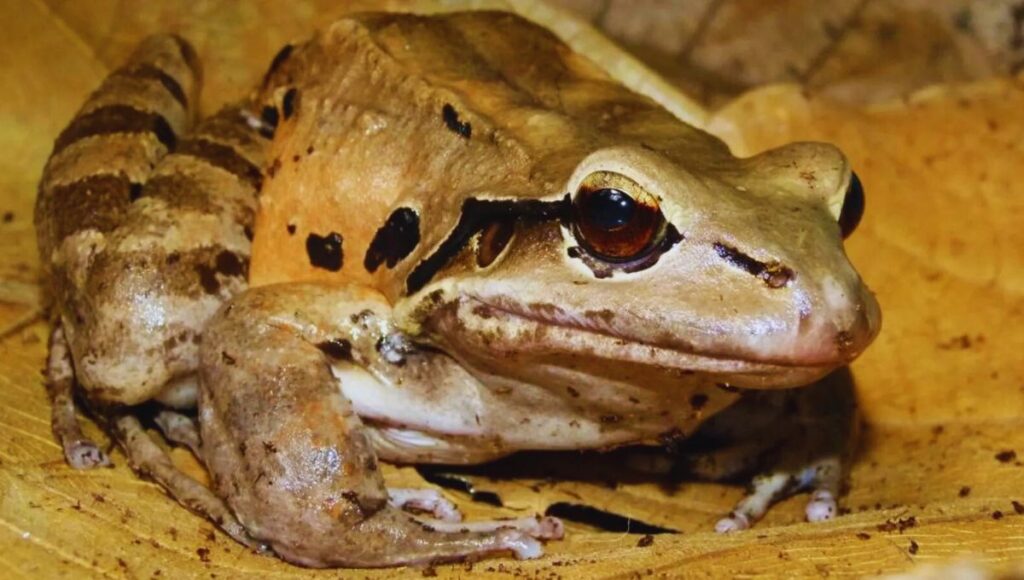
Table of Contents
Mountain Chicken- In a Glimpse:
| Common Name: | Giant Ditch Frog |
| Scientific Name: | Leptodactylus fallax |
| Other Name: | Mountain Chicken |
| Group Name: | Army, Chorus, Colony |
| Adult Weight: | up to 1 kg |
| Adult Length: | up to 22 cm or 8.7 inch |
| Colour: | from chestnut brown to barred or spotted |
| Body Structure: | Muscular |
| Distribution: | Montserrat and Dominica islands of the Caribbean Sea |
| Habitat: | Moist habitats (primarily near springs and streams and rarely in grasslands). |
| Lives in: | Burrows |
| Character: | Monogamous or Polygamous |
| Diets: | Carnivorous, crickets, insects, bats, rats, other frogs etc. |
| Predators: | feral cats, dogs, pigs, rats and opossums. |
| Threats: | chytridiomycosis disease, human activities such as the expansion of agriculture, industrialisation, unawareness of local people, toxic paraquat etc. |
| IUCN Status: | Critically Endangered |
Everything About Mountain Chicken (Giant Ditch Frog):
Scientific Classification:
| Domain: | Eukaryota |
| Kingdom: | Animalia |
| Phylum: | Chordata |
| Class: | Amphibia |
| Order: | Anura |
| Family: | Leptodactylidae |
| Genus: | Leptodactylus |
| Species: | Leptodactylus fallax |
Physical Description of Mountain Chicken:
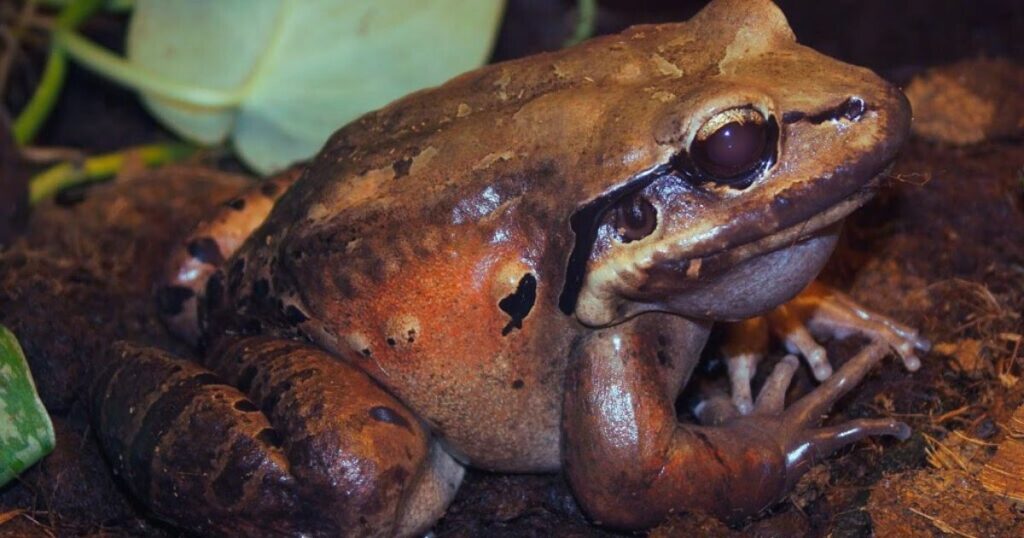
The frog species is one of the largest frogs in the world and the biggest frog in its family (Leptodactylidae). It can weigh up to 1 kg or 2.2 lb and 22 cm or 8.7 inches in snout–to–vent length. The frog species show dimorphism as the female species is usually larger than males.
The mountain chickens have various colours from chestnut-brown to barred or spotted. The colour becomes more orange-yellow on the body and pale yellow on the underparts. A black line runs through the body till snout to mouth and upper legs are broad bandings. Large, conspicuous eyes with golden iris and dark pupils are a distinctive feature of the giant ditch frog.
The species has a robust body with a large head and well-muscled legs. The male frog can be identified from female mountain chickens as they are smaller in size and males have black spurs on each of their thumbs to grasp the females while mating or amplexus.
Distribution and Habitats of Giant Ditch Frog:
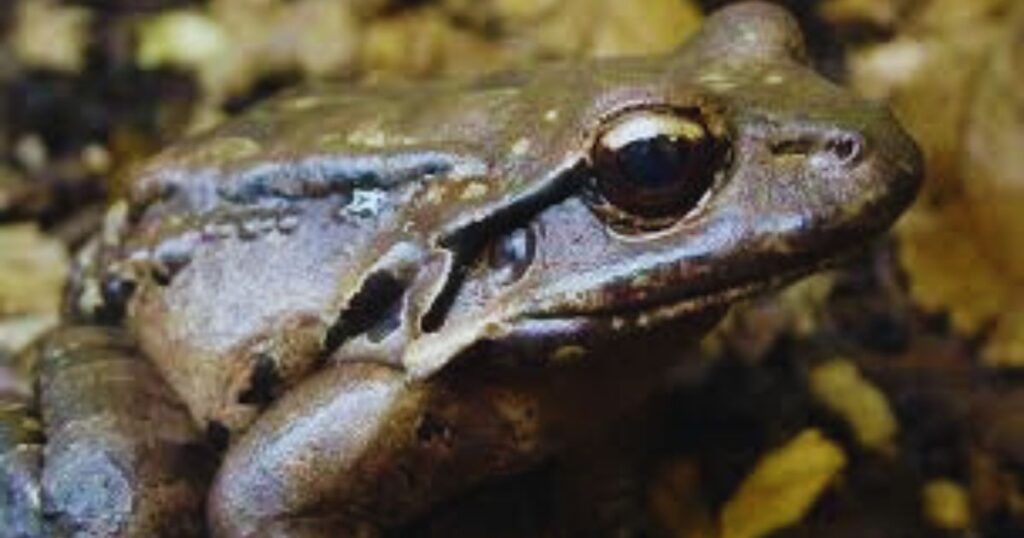
Once upon a time mountain chickens were found on many parts of Lesser Antillean islands in the Caribbean island, but currently, it is restricted to only Dominica and Montserrat. The giant frog species is now extirpated from Guadeloupe, Martinique, Saint Kitts and Nevis which were the kingdom of the frog.
Although there was an unsuccessful initiative to introduce the giant ditch frog to Jamaica and Puerto Rico. In the early 2000s, due to a volcanic eruption, the frog species was lost from most parts of Montserrat, except Centre Hill of northern Montserrat. But the good news is mountain chicken is found in both the western and eastern sides of Dominica.
The giant ditch frog usually prefers a moist environment. It is found in dense forests, scrub, hillside plantations, palm groves in river valleys, ravines and flooded forests. The frog is mostly found near streams and springs due to humid conditions and is rarely found in grasslands.
Behaviour:
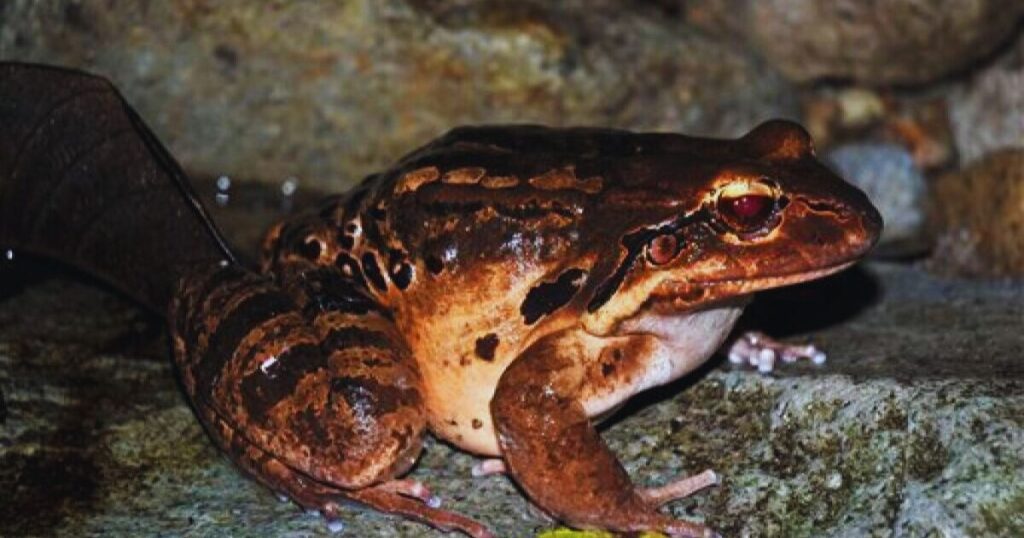
The frog species is terrestrial and nocturnal. The mountain chicken is an opportunistic predator which sits and waits for a long time to find prey. They are strictly carnivorous and consume almost everything that can be swallowed whole.
At night, they show camouflage in the vegetation (typically a mix of green and brown) and wait and attack the prey with their impressive jumping abilities.
The giant ditch frogs usually consume crickets, insects, spiders, other frogs, bats, snakes and eggs (other than unfertilized ones). However, the frog species eat other frogs but cannibalism is not known in their community. During the day, they prefer to live in burrows which are dug into most soil.
Ecological Importance of Mountain Chicken:
The giant frog plays an important role in the ecosystem of its natural habitat. As a predator, it feeds on insects, spiders, rats, snakes and other frogs and controls their population.
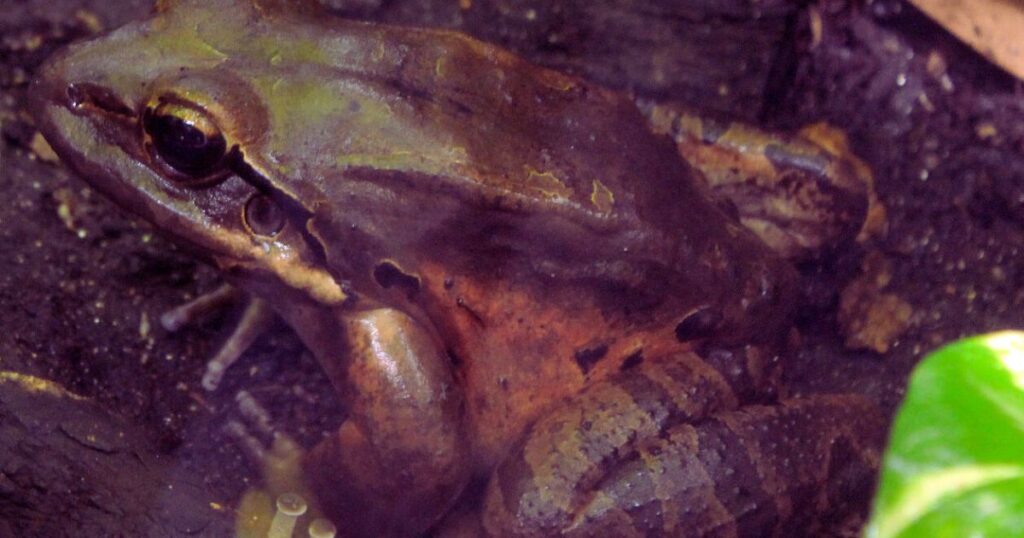
On the contrary, they maintain the food chain by serving themselves as the prey for larger predators. By maintaining a balanced ecosystem, the giant ditch frog indirectly helps the plants to grow and maintains the overall health of the ecosystem.
Cultural Significance of Giant Ditch Frogs:
Over the years, the frog species is associated with the folklore and local culture of the region. Indigenous communities consider the frog as a mystical property and incorporate it into their myths and traditional rituals.
Unfortunately, the cultural value of mountain chicken hurts the frog species. It contributes to the overharvesting of the species for consumption leading to a decline in its population.
Reproduction:
| Mating Behaviour: | Monogamous and Polygamous |
| Mating Technique: | Amplexus |
| Breeding Season: | April – September |
| Breeding Interval: | 1 year |
| Sexual Maturity: | 3 year |
| Life Span: | 12 year |
| Infants Name: | Tadpole |
The mountain chicken has a very unusual method of breeding as they breed in burrows which are at least 50 cm deep. The breeding season usually starts in April and continues to August and September.
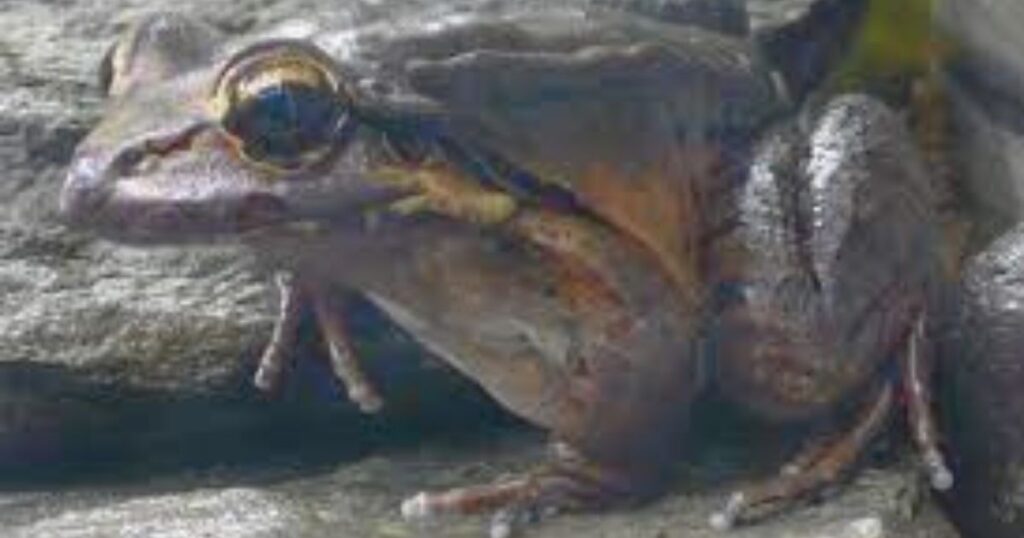
At the start of the mating period, the male frogs compete to get access to the preferred nesting place by wrestling and creating loud ‘whooping’ calls from their forest paths and undergrowth clearings. The winner captures the burrow and emits ‘trilling barks’ to attract a female partner.
Once the breeding pair is formed they engage in amplexus and after 9-14 hours when the nest is built, the male leaves the burrow and defends it against the intruders and the female lays an egg inside the burrow. After the tadpoles have hatched the female lays up to 25000 unfertilized eggs upon which the tadpoles feed.
After laying eggs, the female leaves the nest and the male returns and shows paternal care to the tadpoles. The male frog transports the newly formed tadpoles to the nearby water bodies. It is a process to ensure the safety and increase the survival opportunities of the tadpoles.
The time taken by the young to develop is around 45 days and 26-43 froglets emerge from the nest when the wet season arrives as food is abundant.
A mountain chicken usually reaches maturity at 3 years of age and can live up to 12 years. The mature female usually produces one brood per season and the males may have more than one female partner.
Predators:
As the Mountain Chicken is the secondary consumer in the food web, they are predated by feral cats, dogs, pigs, rats and opossums.
Mountain Chicken is a Misnomer:
The nickname of giant ditch frog is given to mountain chicken because, in the local delicacy of Dominica and Montserrat, islands in the Caribbean Sea, the frog tastes similar to chicken.
Why is Mountain Chicken in Danger?
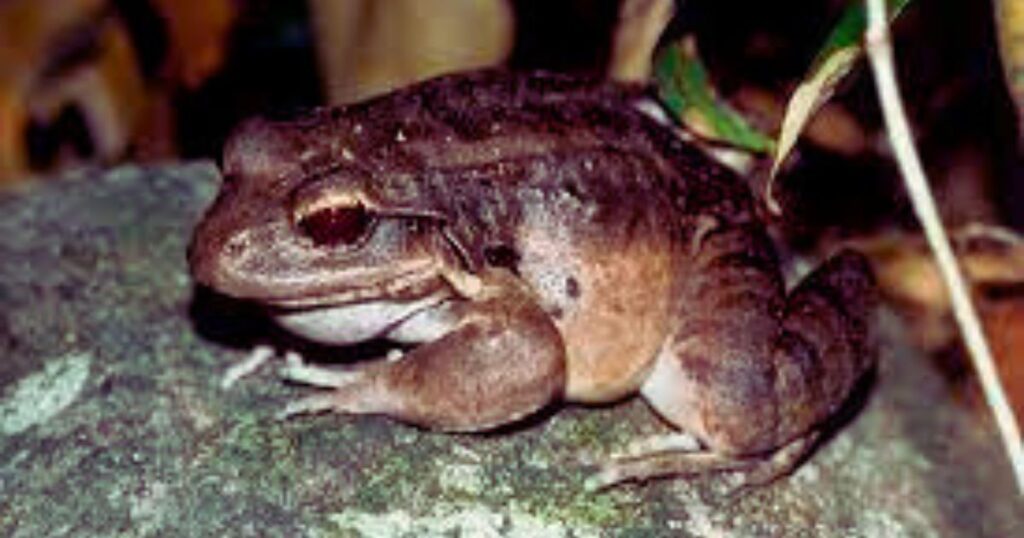
Unfortunately, the mountain chicken faces a lot of threats in the ecosystem that lead to a sharp decline in their population. One of the primary reasons is a disease related to the chytrid fungus, Batrachochytrium dendrobatidis, that causes chytridiomycosis disease. This fungal infection affected badly the amphibian population around the world and the Giant Ditch frog is no exception.
Moreover, there are anthropogenic threats also present. On Dominica, this frog species was hunted because of the meaty flavour of its legs. It was the national dish of the island for a long time and it is another reason why the population of the frog species declined at a fast pace.
The frog is generally confined to the coastal area. The increasing human activity near the coastal area as agriculture, tourist spots, human settlements and industrial developments also harm the species. The presence of the toxic herbicide Paraquat in the region due to industrialization also decreases the population of the giant frog.
Conservation Status of Mountain Chicken:
According to the IUCN Red List of Threatened Species, Mountain Chicken is listed as a “Critically Endangered” species. However, the species is not listed in CITES.
Relatives of the Giant Ditch Frog:
| Name of the Species | IUCN status |
| Hispaniola Yellow Tree Frog | VULNERABLE |
| Horned Frog | LEAST CONCERN |
| Pumpkin Toadlet | LEAST CONCERN |
| Marbled Reed Frog | LEAST CONCERN |
Conservation Efforts:
Hunting of the frog species was banned in the later 1990s as the population of the species dropped 80% in a short span of time. However, a 3-month open season was declared in 2001 but hunting was not totally prohibited till 2003. Public awareness programs were put forward and encouraged the preservation of the giant frog.

In July 1999, Durrell Wildlife Trust (DWT) tried a captive breeding study which was implemented successfully and formed the base for the insurance population of the species. Since January 2008, Montserrat Forestry and Environment Division in partnership with Fauna and Flora International have been monitoring the mountain chicken in the wild.
One of the major threats to mountain chicken is chytridiomycosis which is given priority over any other threats. To counter this threat, field studies, capacity building, species reintroduction and anti-fungal treatments are used. The frog species are well breeding in captivity and were successfully reintroduced in 2011-12.
On Dominica, a captive breeding facility has been built and is used to examine the skin to find out the presence of chytridiomycosis. A group of scientists are working together dedicatedly to ensure the survival of mountain chickens on the Caribbean islands, especially in Dominica and Montserrat.
Can you buy a mountain chicken frog or a giant ditch frog as a pet?
First, Mountain Chicken frogs are unsuitable as pets because they require certain environmental conditions and care that are very difficult to replicate outside their habitat. Thus, giant ditch frogs are very difficult to breed in captivity. Only professionals are allowed to breed them in Captivity.
Second, The number of mountain chickens is rapidly decreasing; hence, it is listed as a critically endangered species in the IUCN Red List of Threatened Species. Trading of these frog species is banned in most of the countries in the world.
Third, You can’t have a giant ditch frog at your home without a permit from the government. Only zoos and conservation organizations that are part of the global recovery program are allowed to keep the frog on their premise.
Frequently Asked Questions (FAQs):
Why is it called a mountain chicken if it is a frog?
The nickname arrives because the meat of the frog tastes like a chicken. It used to be one of the very popular delicacies in the islands of Montserrat and Dominica.
Is Mountain Chicken a toad?
Yes, unlike the name it is a toad. Mountain chicken is also known as the giant ditch frog and it is one of the largest frogs in the world. It can weigh up to 1 kg and can be 22 cm long from snout to vent. The females are a little larger than the males.
Does Mountain chicken taste like chicken?
It used to be one of the most popular delicacies in the islands of Montserrat and Dominica in the Caribbean Sea. The frog species tastes like a chicken and thus it is also called a mountain chicken.
Who are the Predators of Mountain Chickens?
Mountain chickens are generally a secondary consumer in the food chains. Larger carnivorous animals like feral cats, dogs, pigs, rats and opossums often hunt them and consume them.
What is the lifespan of a mountain chicken?
A mountain chicken reaches its maturity around 3 years of age and can live up to 12 years.
What are the main threats of mountain chicken?
One of the major threats to the species is chytridiomycosis disease which is caused due to chytrid fungus (Batrachochytrium dendrobatidis). The other threats are human activities, expansion of agriculture and industries around the coastline, pollution and the presence of toxic chemical substances in the region also harm the species.
References: Leptodactylus fallax on Wikipedia